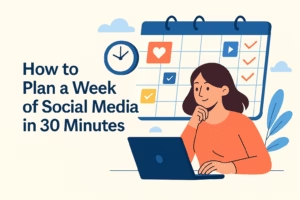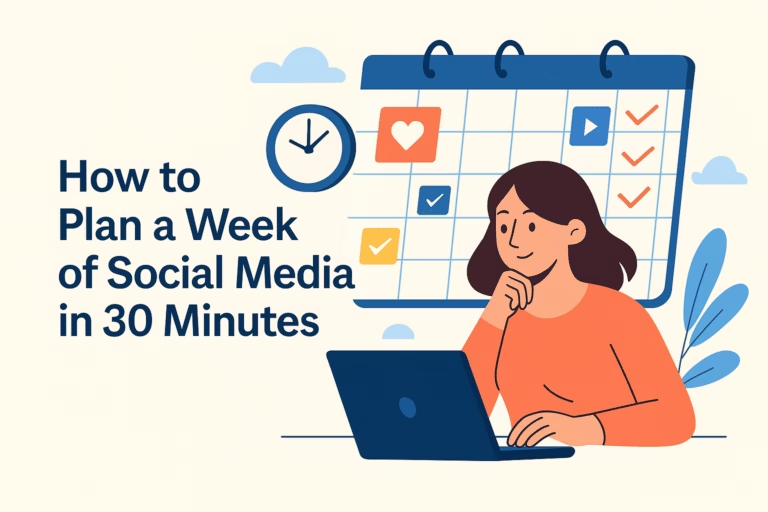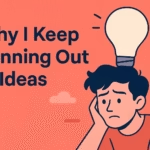Key Takeaways
- Planning reduces decision fatigue. Three blocks of ten minutes are enough to map a full week.
- Use stable weekly themes so ideas flow faster and your audience knows what to expect.
- Generate ideas quickly, then assign format and platform in one sitting to close the loop.
- Automation should publish and pace your posts. Your job is replies, nuance, and tone.
- Iterate lightly. Change hooks, formats, or CTAs before throwing away a theme.
- Consistency is rhythm, not pressure. Plan once, engage daily, and protect your attention.
Every creator knows this feeling. You open your phone to post, scroll through your gallery, and think, “None of this feels right.” You’ve got half-written captions, screenshots meant for “later,” and a growing sense that your audience expects something — but you’re not sure what.
That’s the quiet chaos of daily posting. It looks like discipline from the outside, but inside it feels like panic dressed as productivity. Each day starts with the same small storm:
“What do I post today?”
“Didn’t I already say that?”
“Is this even good enough?”
The truth is, most creators don’t burn out from lack of creativity. They burn out from constant decision-making. Every post becomes a new project. There’s no system, only scramble.
This is why your feed feels inconsistent. Some days you sound sharp, others scattered. You’re trying to build an audience on top of daily uncertainty. It’s not that you don’t have ideas it’s that you have too many, and no plan to organize them.
Planning is what separates creators who look calm from those who feel like they’re drowning. It doesn’t mean overthinking; it means pre-deciding once, so you don’t have to overthink seven times.
In the next section, we’ll strip away the myth that planning is complicated and uncover why it feels heavier than it actually is.
Why Planning Feels Harder Than It Should
Planning feels heavy because it exposes something most creators try to avoid clarity. When you sit down to plan, you’re not just choosing what to post; you’re choosing who you are online. That’s where the pressure starts. Every decision feels permanent. Every idea feels like a statement of identity.
Then comes perfectionism. You want your grid to look cohesive, your captions to sound insightful, and your tone to stay on-brand. So instead of writing, you tweak. Instead of scheduling, you second-guess. Planning morphs into performance, and you end up walking away with a half-filled calendar and a full dose of guilt.
There’s also the mental tax of switching contexts. You’re juggling ideas, analytics, and visuals while trying to predict audience reaction. No wonder it feels exhausting. Planning manually every week forces your brain to handle logistics and creativity at the same time two tasks that drain each other.
The solution isn’t to “try harder.” It’s to make planning lighter. When you separate thinking, organizing, and executing into short, focused bursts, you regain control of your attention. You stop trying to plan the perfect month and start designing a repeatable rhythm.
The next section will walk you through that rhythm a 30-minute framework that gives structure to chaos without killing creativity.

The 30 Minute Planning Framework
Most creators overcomplicate planning because they think it requires long strategy sessions, color-coded calendars, and dozens of templates. The truth is, a simple, well-structured 30 minutes can do more for your consistency than an entire afternoon of scattered effort.
Think of this as a mini creative sprint. You only need half an hour, divided into three focused blocks of ten minutes each. The goal is not to fill the month. The goal is to create clarity for the next seven days so you can post with calm, not chaos.
First 10 minutes – Define your themes
Pick three content themes for the week. These should align with your brand pillars, such as educate, engage, and promote. You don’t need to reinvent them weekly. Keep them steady so your audience knows what to expect.
Next 10 minutes – Generate quick ideas
For each theme, write two or three content ideas. Keep it raw. You’re not crafting captions here, just noting sparks. If one idea feels flat, twist it by asking, “What’s the opposite of this?” or “How would I explain this to a friend?” You’ll end up with six to nine usable ideas in minutes.
Final 10 minutes – Plan and automate

Decide how those ideas will appear. Will it be a carousel, a short video, a quote, or a story sequence? Assign each idea a day and platform, then schedule it using Blaze Autopilot. The tool helps you queue posts, tweak captions for each platform, and publish them automatically at the best time for engagement.
Once you hit schedule, you’re free. The mental load disappears, and you can focus on creativity instead of logistics.
When you repeat this every Sunday or Monday, you move from panic to flow. The structure never changes — only the ideas do. That’s how professionals stay visible without feeling buried.
Next, we’ll visualize what this looks like in a real weekly plan.
Execution Tools That Do the Heavy Lifting
Planning is the thinking. Execution is the relief. Once your weekly plan is set, use a scheduler to queue posts, adjust timing per platform, and preview how captions look in different contexts. Good tools also let you bulk upload assets, tweak copy per channel, and see a single calendar view so nothing slips.
Keep two habits tight. First, schedule in one sitting so you do not re-open the loop all week. Second, set a ten minute daily window to reply to comments and DMs so your presence still feels human. Automation handles delivery. You handle connection.
If a post underperforms, do not scrap the theme. Rewrite the hook, change the format, or shift the CTA. Small edits beat total rewrites. Execution is iteration, not reinvention.
Planning without follow-through is just a prettier version of procrastination. The real win comes when your plan turns into motion automatically. Once you’ve outlined your posts and formats, drop them into a scheduler so you’re never scrambling at 9 a.m. trying to find the right caption.
This is where automation earns its keep. Tools like Blaze Autopilot remove the mental overhead of “remembering.” They queue your posts, optimize timing per platform, and repurpose your content across Instagram, LinkedIn, and X with just a few edits. You don’t lose control — you just stop micromanaging the clock.
Creators often fear automation will dull their tone, but it does the opposite. When logistics are handled, you show up calmer, sharper, and more human. The audience feels that difference. The energy once spent on scheduling now feeds creativity, storytelling, and genuine engagement.
Think of automation as your silent team — it never forgets, never panics, and never burns out. It just keeps your rhythm steady while you focus on the part that matters most: showing up with clarity.
Winding Up
Thirty minutes of planning protects seven days of peace. When your workflow becomes predictable, the noise quiets. You’re no longer chasing inspiration or panicking about what to post next — you’re executing with intention.
The best creators are not those who post the most; they’re the ones who plan once and rest easy. Systems buy you time, and time buys you clarity. With a structure in place, your energy can finally return to creativity — where it belongs.
Consistency stops being a burden when it becomes routine. Plan your week, schedule your posts, and trust your system. Automation handles the weight; your job is to keep the voice honest.
When you blend preparation with presence, you create something most creators never reach — rhythm. That is how you stay relevant, rested, and still unmistakably human.



